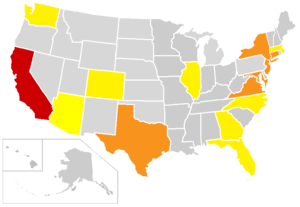 Iranian American population by state | |
| Total population | |
|---|---|
| 568,564 (2020 Census)[1] 470,341 (ACS, 2011)[2] 1,500,000 (other estimates)[3][4][5] | |
| Regions with significant populations | |
| California (largest populations in Los Angeles, Orange and San Diego counties), New York, New Jersey,[6] Texas, Connecticut, Maryland, Virginia, Washington, D.C., Illinois, Michigan,[7] Northeast Ohio,[8] Florida, Georgia | |
| Languages | |
| American English, As well native (Persian, Azerbaijani, Armenian, Kurdish, and other languages of Iran). | |
| Religion | |
| Islam 31%, Atheism/Realism/Humanism 11%, Agnosticism 8%, Baháʼí 7%, Judaism 5%, Protestanism 5%, Roman Catholicism 2%, Zoroastrianism 2%, Other 15% including Mandaeanism, and No Response 15%.[9][a] | |
| Related ethnic groups | |
| Iranian diaspora (Iranians of UAE • Ajam of Bahrain • Ajam of Qatar • Ajam of Iraq • 'Ajam of Kuwait • Iranians of Canada • Iranians of America • Iranians of UK • Iranians of Germany • Iranians of Israel • Iranians in Turkey) Iranian Peoples (Lurs, Achomis, Baluchs, Kurds, Iranian Azeris), Turkic peoples (Qashqai, Azerbaijanis), Huwala | |
^a A 2012 national telephone survey of a sample of 400 Iranian-Americans in the Los Angeles area, commissioned by the Public Affairs Alliance of Iranian Americans and conducted by Zogby Research Services, asked the respondents what their religions were. The survey had a cooperation rate of 31.2%. |
Iranian Americans, also known as Persian Americans, are citizens or nationals of the United States who are of Iranian ancestry.
Most Iranian Americans arrived in the United States after 1979, as a result of the Iranian Revolution and the fall of the Iranian monarchy, with over 40% settling in California, specifically Los Angeles. They have created many distinct ethnic enclaves, such as the Los Angeles Tehrangeles community in Westwood, Los Angeles. Based on a 2012 announcement by the National Organization for Civil Registration, an organization of the Ministry of Interior of Iran, the United States has the greatest number of Iranians outside the country.[5][10]
Iranian Americans are among the most highly educated people in the United States.[11][12] They have historically excelled in business, academia, science, the arts, and entertainment. Many have become doctors, engineers, lawyers, and tech entrepreneurs.[13][14]
Research by the Iranian Studies Group at the Massachusetts Institute of Technology in 2004 estimated the number of Iranian Americans at 691,000, about half of which live in the US state of California.[11][15][16]
- ^ "3.5 Million Reported Middle Eastern and North African Descent in 2020".
- ^ U.S. Census Bureau (2011 American Community Survey 1-Year Estimates). Retrieved 7 January 2016.
- ^ "How many Iranians are in the U.S.A?". Shargh Newspaper (in Persian). Entekhab Professional News Site. 20 May 2012. Retrieved 11 April 2017.
- ^ "Revealing of the number of Iranians in the outside Iran". Hafte Sobh Newspaper (in Persian). Bartarinha News Portal. 9 September 2012. Retrieved 11 April 2017.
- ^ a b "Iranian National Organization for Civil Registration: More than 2 million Iranians live in the U.S.A and the U.A.E" (in Persian). Radio Farda. 7 September 2012. Retrieved 11 April 2017.
- ^ Alvarado, Monsy (20 March 2014). "N.J. Iranians celebrate Persian New Year with music, dance in Englewood". North Jersey Media Group. Archived from the original on 22 March 2014. Retrieved 21 March 2014.
- ^ Fata, Soraya; Rafii, Raha (September 2003). "The Relative Concentration of Iranian Americans Across the United States: Iran Census Report" (PDF). National Iranian American Council. Archived from the original (PDF) on 5 January 2019. Retrieved 12 January 2016.
- ^ Vandenberge, Jordan (3 January 2020). "Iranian-Americans in Cleveland keeping close eye on rising tensions between US, Iran". WEWS-TV. Retrieved 13 June 2021.
- ^ "2012 National Public Opinion Survey of Iranian Americans regarding Potential Military Strike Against Iran" (PDF). paaia.org. 2012. p. 14. Archived from the original (PDF) on 25 July 2012. Retrieved 12 February 2019.
- ^ "Archived copy" (PDF). Archived from the original (PDF) on 5 June 2021. Retrieved 6 June 2021.
{{cite web}}: CS1 maint: archived copy as title (link) - ^ a b "Migration Information Source – Spotlight on the Iranian Foreign Born". Migrationinformation.org. June 2006. Retrieved 15 February 2010.
- ^ "Iranian-Americans Reported Among Most Highly Educated in U.S." Payvand.com. 24 November 2006. Archived from the original on 6 March 2023. Retrieved 15 February 2010.
- ^ Ansari, Azadeh (16 June 2009). "Iranian-Americans cast ballots on Iran's future". CNN. Retrieved 15 February 2010.
- ^ Etehad, Melissa (4 February 2019). "They can't go back to Iran. So L.A. Persians built 'Tehrangeles' and made it their own". Los Angeles Times. Retrieved 3 October 2019.
- ^ McIntosh, Phyllis. "Iranian-Americans Reported Among Most Highly Educated in U.S.: Iranian-Americans also contribute substantially to the U.S. economy". State Department Bureau of International Information Programs. Retrieved 12 January 2016.
- ^ Amirani, Shoku (29 September 2012). "Tehrangeles: How Iranians made part of LA their own". BBC News. BBC. Retrieved 17 April 2014.